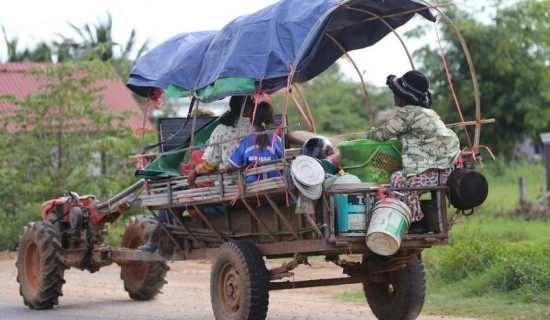- Saturday, 2 August 2025
All efforts to get rid of cockroaches prove futile
By Arpana Adhikari,Kathmandu, May 20: If six-legged crawlers with twitching antennae are swarming your kitchen, lurking in your bathroom or creeping into your wardrobe and no spray, insecticides and DIY tricks keep them away, you are not alone. It is waterloo for many.
Across Kathmandu, households are now waging a losing battle against cockroaches. Despite countless attempts to control their spread, these uninvited guests continue to thrive, overcome and survive almost every method to control them. The problem is not just persistent, it’s growing in the urban areas.
Basanti Bastola, a journalist and Vice-Chairperson of Sancharika Samuha, who lives in Dhapasi Height, shared a horrifying account of how she and her family have been suffering due to cockroach infestation.
“The cockroaches have eaten through my cotton clothes, destroyed expensive bags and even damaged several electrical appliances. They can get into almost anything and leave behind filth, including droppings and eggs, which causes further damage,” she said.
“What’s even more disturbing is that they’ve started biting us,” Bastola said in frustrated voice. “I notice tiny holes near my fingernails and my daughter’s as well. When I mentioned it to friends, they confirmed they were most likely cockroach bites.”
She added that her home is now flooded with cockroaches of three different sizes (small, medium and bigger one), invading everything from kitchen cabinets, food grains and wardrobes to electronics and personal belongings.
Mandira Giri, a housewife from Sifal, shared her distress over a severe cockroach infestation at her home, particularly in the kitchen and bathroom, where hundreds of tiny cockroaches, each about half an inch long, have taken over.
“The small-sized cockroaches are everywhere,” she said, adding, “Because they’re so tiny, they can crawl into anything, our water filter, induction stove, gas stove, exhaust fan and damage them,” she added.
While thousands of cockroach species exist globally, three main types are commonly found in Nepal, the smaller German cockroach, the larger American cockroach and a hybrid of the two.
Adding to her frustration, Giri said, “If we finish our chores at night and return to the kitchen for any reason, the moment we switch the light on, the entire floor is covered with cockroaches,” said Giri.
What’s worse, she explained, is the dirt they leave behind. “Their droppings are scattered all over the ceiling like tiny black dots. There isn’t a single place untouched, whether it’s utensils or food items packed in jars. No matter how many times we clean or cover the food, their dropping still finds their way in, leaving a foul smell behind. Cockroaches are everywhere,” she added.
She shared she now washes every utensil with drinking water before use, but even that turns out to be pointless.
Sharada Acharya from Mandikhatar echoed similar frustration, sharing that the bigger- cockroaches have infested her kitchen and bathroom. “No matter how much I clean, they just won’t disappear,” she said.
She suspects the infestation began after bringing items from her maternal home, which was already infested.
Kamala Panthi, Chairperson of Sancharika Samuha, is equally overwhelmed. “I kill them as soon as I see them,” she said. “Just days ago, I found one in my wardrobe and had to empty and clean the entire thing.”
She is facing challenges not only at her home in Lokanthali, Bhaktapur, but also at the Sancharika Samuha Office, Lalitpur, which hasn’t been spared either.
But this isn’t just their story; households, restaurants, banks, hotels, department stores and commercial buildings across the valley are battling a similar crisis.
On RedditNepal, a social media platform, hundreds of posts reflect public frustration, with users desperately seeking solutions.
Despite trying every option available in the market, Laxman Rekha and insecticide sprays like Baygon, Kala Hit, Lal Hit and more, people like Bastola, Giri, Acharya and countless Reddit users say nothing has worked to get rid of these pesky pests.
Beyond their filthy appearance and foul smell, cockroaches pose serious health risks by spreading diseases like food poisoning, allergic asthma and skin allergies.
Dr. Sher Bahadur Pun, Chief of the Clinical Research Unit at Sukraraj Tropical and Infectious Disease Hospital said cockroaches are a growing problem in the urban areas like Kathmandu due to climate change, rapid urbanisation, population pressure and people’s increased mobility.
Stating that Kathmandu’s dense population and waste generation create ideal breeding grounds, he said when cockroaches infest a space, they make it difficult to maintain cleanliness, as they leave behind droppings, saliva and body parts, leading to asthma and skin allergies triggered by cockroach allergens. They can spread germs and bacteria, leading to illnesses such as food poisoning and diarrhea, added. Dr. Pun.
Sandesh Acharya, founder of All Nepal Pest Control (ANPC), said cockroaches have become second most pressing problems faced by the locals of Kathmandu, after bed bugs.
Common area of cockroach infestation are places that are warm and moist, especially in kitchens, bathrooms, trash areas and basements, he informed.
According to Acharya, they are currently providing regular pest control services to around 150 restaurants in Kathmandu, along with several commercial buildings such as banks, department stores, shopping malls and hotels.
However, he said that awareness among households remains low, with only 15-20 homes having used their services so far. “Maintaining cleanliness alone is not enough to control a cockroach infestation, it requires proper interventions, like professional pest control.”
He claimed that pest control can effectively eliminate both cockroaches and bed bugs if treatments are applied regularly for certain period of time, ideally, twice a month. Otherwise, the infestation is only managed, not wiped out.
The cost of pest control generally ranges between Rs. 5,000 to Rs. 10,000, depending on various factors.
Explaining why cockroaches are so difficult to eliminate once they infest a home or building, Acharya said, “Cockroaches are incredibly adaptable and resilient. They have existed for over 300 million years and can survive in almost any environment. Their bodies are built to withstand extreme conditions.”
















